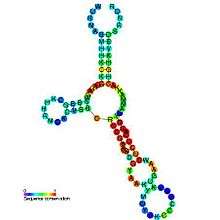Glycine riboswitch
| Glycine riboswitch | |
|---|---|
 | |
| Predicted secondary structure and sequence conservation of Glycine | |
| Identifiers | |
| Symbol | Glycine |
| Alt. Symbols | gcvT |
| Rfam | RF00504 |
| Other data | |
| RNA type | Cis-reg; riboswitch |
| Domain(s) | Bacteria |
| SO | 0000035 |
The bacterial glycine riboswitch is an RNA element that can bind the amino acid glycine. Glycine riboswitches usually consist of two metabolite-binding aptamer domains with similar structures in tandem. The aptamers were originally thought to cooperatively bind glycine to regulate the expression of downstream genes. In Bacillus subtilis, this riboswitch is found upstream of the gcvT operon which controls glycine degradation. It is thought that when glycine is in excess it will bind to both aptamers to activate these genes and facilitate glycine degradation.[1]
The originally discovered, truncated version of the glycine riboswitch exhibits sigmoidal binding curves with Hill coefficients greater than one, which led to the idea of positive cooperativity between the two aptamer domains.[1][2] Data in 2012 shows that cooperative binding does not occur in the switch with its extended 5' leader, though the purpose of the switch's dual aptamers is still uncertain.[3]
Atomic resolution structures of portions of glycine riboswitches have been obtained by X-ray crystallography.[4][5]
References
- 1 2 Mandal, M; Lee M; Barrick JE; Weinberg Z; Emilsson GM; Ruzzo WL; Breaker RR (2004). "A glycine-dependent riboswitch that uses cooperative binding to control gene expression". Science. 306 (5694): 275–279. doi:10.1126/science.1100829. PMID 15472076.
- ↑ Kwon, M; Strobel SA (2008). "Chemical basis of glycine riboswitch cooperativity". RNA. 14 (1): 25–34. doi:10.1261/rna.771608. PMC 2151043
 . PMID 18042658.
. PMID 18042658. - ↑ Sherman, E. M.; Esquiaqui, J.; Elsayed, G.; Ye, J.-D. (25 January 2012). "An energetically beneficial leader-linker interaction abolishes ligand-binding cooperativity in glycine riboswitches". RNA. 18 (3): 496–507. doi:10.1261/rna.031286.111.
- ↑ Butler, EB; Xiong Y; Wang J; Strobel SA (2011). "Structural Basis of Cooperative Ligand Binding by the Glycine Riboswitch". Chem. Biol. 18 (3): 293–298. doi:10.1016/j.chembiol.2011.01.013.
- ↑ Huang, L; Serganov A; Patel DJ (2010). "Structural insights into ligand recognition by a sensing domain of the cooperative glycine riboswitch". Mol. Cell. 40: 774–786. doi:10.1016/j.molcel.2010.11.026.